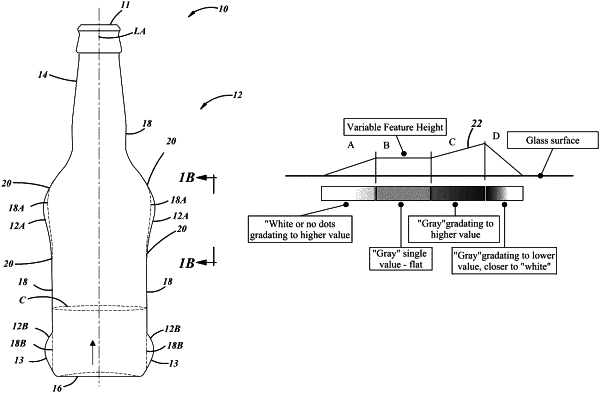| CPC C03C 17/005 (2013.01) [B05D 5/061 (2013.01); B05D 5/065 (2013.01); B05D 5/066 (2013.01); B29C 64/112 (2017.08); B29D 22/003 (2013.01); B41J 3/4073 (2013.01); B41J 3/40733 (2020.08); B41M 5/0041 (2013.01); B41M 5/0047 (2013.01); B41M 5/007 (2013.01); B41M 5/0082 (2013.01); B41M 5/0088 (2013.01); C03B 9/03 (2013.01); C03B 9/14 (2013.01); C03B 9/193 (2013.01); C03B 9/325 (2013.01); C09D 5/002 (2013.01); C09D 11/101 (2013.01); C09D 11/30 (2013.01); B05D 2203/35 (2013.01); B29C 2035/0827 (2013.01); B29C 2795/007 (2013.01); B29L 2031/7158 (2013.01); B33Y 40/10 (2020.01); B33Y 40/20 (2020.01); B41M 7/0081 (2013.01); C03C 23/007 (2013.01); C03C 2218/119 (2013.01); C03C 2218/31 (2013.01)] | 20 Claims |

|
1. A method of printing three-dimensional (3D) features on a glass container, the method comprising:
applying a first layer of UV-curable material on a surface of the glass container around a circumference of the container;
curing the first layer of UV-curable material by directing UV light toward the applied first layer of UV-curable material to produce a first cured material layer that forms at least a portion of a first 3D feature on the glass container;
applying a second layer of UV-curable material on the surface of the glass container, spaced apart from the first 3D feature, around the circumference of the container; and
curing the second layer of UV-curable material by directing UV light toward the applied second layer of UV-curable material to produce a second cured material layer that forms at least a portion of a second 3D feature on the glass container,
wherein a portion of the glass container between the first and second 3D features has a circumference less than that of the first or second 3D features,
wherein the applying of the first layer and the second layer of UV-curable material is based on assigned grayscale values.
|